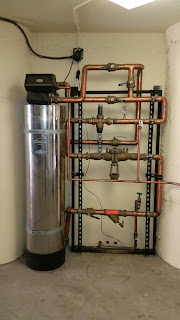Here are three possibilities that could be happening right now in your home.
In most cases, plumbing problems usually revolve around one of three things: clogs, leaks, or drips. One thing is for certain, it always pays to be familiar with your plumbing system so you can minimize the damage caused by plumbing problems as well as fix minor plumbing problems on your own.
1. The most important thing is your Health. I can install a plumbing system to provide you with the pure clean water. Find out how clean is your drinking water with a TDS meter (total dissolved solids). The EPA classifies pure water as 010 parts per million. The tap water in Los Angeles County is somewhere on the average of 400 parts per million. This water will make you sick if you drink it. I'm speaking from experience. For example, Aquafina water is the best water to drink if you do not have a Reverse Osmosis System. I do not own or work for Aquafina Corporation. I have tested the water and the TDS is 000.
Water Filter
2nd. important thing you can do is find out where the main water shutoff valve is and how to turn it off. This is usually outside in the front yard area of your home or in your basement or crawlspace. If you can not find it or don’t know how to turn it off, contact us and we will be able to help you.
Being able to shut your water off at the main valve can be vital to reducing damage to your home if a pipe were to burst. You should also check each plumbing fixture, water heaters, sinks, toilets for their own shutoff valves and verify they work. If the valves fail to turn off, you should have them fixed by a professional plumber immediately. These valves come in handy when the need arises to repair individual plumbing fixtures. If an fixture has no valves, you will need to shut off your water at the main shut off valve to repair it.
Hi, my name is Richard Yazmajian. I the owner and plumbing contractor at Richards Rooter and Plumbing since 1994.

Filters use sieving, adsorption, ion exchanges, biofilms and other processes to remove unwanted substances from water. Unlike a sieve or screen, a filter can potentially remove particles much smaller than the holes through which its water passes, such as nitrates or germs like Cryptosporidium.
Among the methods of filtration, notable examples are sedimentation, used to separate hard and suspended solids from water and activated charcoal treatment, where the boiled water is poured through a piece of cloth to trap undesired residuals. Additionally, the use of machinery to work on desalinization and purification of water through the transposal of it into multiple-filtration water tanks. This technique is aimed at the filtration of water on bigger scales, such as serving entire cities.
These three methods are particularly relevant, as they trace back to centuries and are the base for many of the modern methods of filtration utilized today.
No comments:
New comments are not allowed.